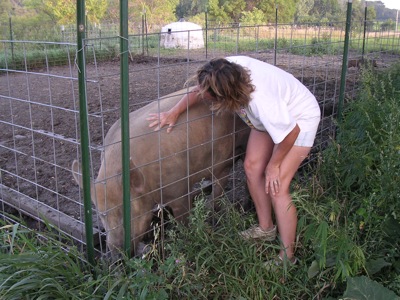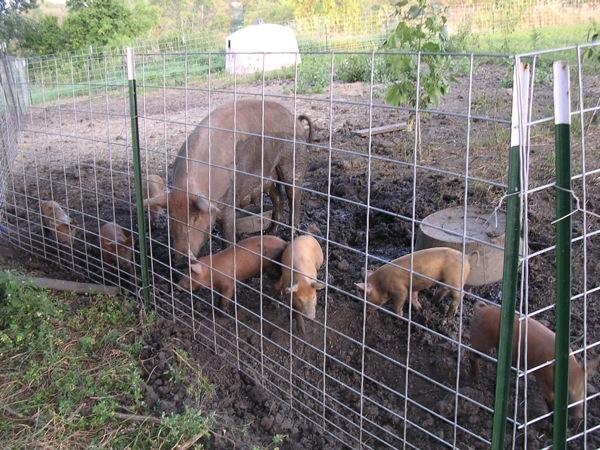“Of all the major livestock species, none is more misunderstood and less appreciated than the hog.”
So starts Storey’s Guide to Raising Pigs by Kelly Klober. Pigs are very often considered dirty animals (have you ever called your kid’s room a “pigsty”?), and generally have a bad reputation in the public eye. As much as I love pork, it was with much trepidation that I traveled to our local pig breeder to bring home two new additions to our growing menagerie. We’d prepared a pen, purchased feed, and read the books (Storey’s Guide, Versa Press 1997 and Raising Pigs Successfully, Kathy and Bob Kellogg, Williamson Publishing, 1985). Nevertheless, my husband Doug understood that if I didn’t like pigs, they wouldn’t be my responsibility.
Our first two oinkers, Porky and Hamlet were 2 month old, 35 pound barrows (castrated male hogs). We brought them home in the back of our pick up, opened the tail gate and released them into their new domain. They had fresh grass, dirt, sunshine, and twice daily corn rations. Pigs are competitive eaters, so two are better than one for rate of weight gain. Our plan was to purchase the pigs in spring, feed them out all summer, and process them in the late fall. In that short time, with minimal time and cost, we would raise two animals that would produce an average of 150 pounds of pork products each. By selling one, we would pay for the other. I found pigs to be friendly, smart, clean animals and gladly took on their care. Both pigs liked to be scratched behind the ears, loved to wallow in mud, and were generally good natured, playful animals. Our success with Pork & Ham led us to purchasing a boar and sow, breeding stock that would enable us to produce our own swine herd.

Charlotte and Wilbur entered our lives the following spring. (Notice they weren’t given food names. Only their young were meant to reach our table.) In our desire to promote breed diversity, we researched various rare species of pig as identified by the American Livestock Breed Conservancy, and decided that Tamworth hogs would suit our purposes nicely. Tamworths are long, lean and athletic “bacon” pigs. They were bred to withstand extreme weather conditions and are exceptional foragers. They are also known for their intelligence and their agreeable disposition.
They were delivered in the back seat of a small car, by a breeder from Northern Minnesota whom we found in the ALBC breeders directory. We had a temporary shelter set up for them but a short time later had to catch them and move them to their permanent home. This proved easier said than done. Doug was adept at diving and snagging a squealing piglet’s hind leg. (You haven’t heard squealing until you’ve heard the sound of a stuck piglet!) The girls jumped in, I sat back and watched, and my mother-in-law photographed the event. Once caught and moved to their new home, the pigs settled in nicely.
The following spring, Charlotte gave birth to her first brood. We learned early on from seasoned farmers that when breeding animals you had live-stock and dead-stock, and the sooner you came to terms with that fact, the easier animal breeding would be. Not all Charlotte’s piglets survived, but we had many strong, hardy piglets that grew quickly. Of the 7 survivors, 2 were male.
When producing meat, it is advisable to castrate males early, as the testosterone will taint the meat. Now, holding on to a squealing, squirming piglet is difficult at any time, suspending one by its hind legs while it’s being castrated was more than I could manage. Doug held the pigs; I had to do the cutting. Now, remember, I am suburb born and bred; the closest I came to cutting into an animal was dissection lab in high school biology. Those creatures neither moved nor made noise.
On the fateful day, Doug caught and held the pigs suspended between his knees while I sprayed the surgical area with iodine and made the necessary cuts. Cutting fast and accurately is important, as the piglets really don’t like an upside-down view of the world, nor do they like being held fast. (The cutting is actaully secondary to these.) Once the procedure is done, you release the piglet, catch the next and repeat…Right. The squealing alarm of the first victim has signaled the rest to run fast and hide well. Fortunately the catching and holding was Doug’s job, and the second male was definitely smoother going; we finished the necessary task expediently. Afterwards, I was amazed and pleased that this “city girl” was able to manage this farm task with minimal squeamishness. Beware if you ever see me wielding a surgical knife and a spray bottle of iodine!
Charlotte’s piglets grew to be fine slaughter hogs. We sold 5 and kept 2 for ourselves. Eventually Wilbur became too large for Charlotte, and kind of scary for my children to manage. A 700 pound, friendly hog could definitely kill you with kindness. Wilbur was sold at auction, and probably made into sausage, and Charlotte was sent to the meat locker. She lived a good life on clean soil, grass, mud, fresh air and sunshine, and we appreciated the meat she provided for our table. We have since held off on acquiring additional pigs, because they require twice daily feedings, and really limit the time we can be away from the farm. We have found a local pork producer, and intend to purchase a hog from them each year.
Baked Apple Pork Loin Chops
- 5 pork loin chops
- 2 T brown mustard
- ¼ c brown sugar
- 2 T soy sauce
- 4 apples
- 1 large onion
- ½ c bread crumbs
- 1 T cinnamon sugar
Preheat oven to 350
Place pork chops on the bottom of a greased baking dish. Combine mustard, sugar and soy sauce and spread on top of pork chops. Peel and slice apples and onions and spread on top of pork chops. Top with bread crumbs and cinnamon sugar. Bake on center rack of preheated oven for 45 minutes.
 Robin Trott grew up in the suburbs of Baltimore, MD and dreamed of the country life. These dreams came true on the eve of her 40thbirthday. Along with her three daughters and husband, she packed up her things and moved to rural west central Minnesota. The years following this major life move have been full of new experiences: raising pigs, poultry, cattle and horses; cut flower production, market gardening, harvesting and preserving food, and living a simple life (read: really, really hard work!). The rewards of the fresh air, good neighbors, clear night skies, and home grown produce and meat are well worth all the sweat and tears put into the farm. She is a devoted “sustainable” farmer, educator, and local food advocate. Her last article for SGT was On Becoming a Farmer.
Robin Trott grew up in the suburbs of Baltimore, MD and dreamed of the country life. These dreams came true on the eve of her 40thbirthday. Along with her three daughters and husband, she packed up her things and moved to rural west central Minnesota. The years following this major life move have been full of new experiences: raising pigs, poultry, cattle and horses; cut flower production, market gardening, harvesting and preserving food, and living a simple life (read: really, really hard work!). The rewards of the fresh air, good neighbors, clear night skies, and home grown produce and meat are well worth all the sweat and tears put into the farm. She is a devoted “sustainable” farmer, educator, and local food advocate. Her last article for SGT was On Becoming a Farmer.




